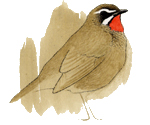PETER MARLER & HANS SLABBEKOORN 2004. Nature's music. The science of birdsong. Elsevier Academic Press, 84 Theobald's Road, London WC1X 8RR, UK; website www.elsevier.com. 504 pp, with two audio CDs. ISBN 0-12-473070-1. GBP 49.95 / EUR 74.95 / USD 74.95.

Nature's music gives an excellent overview of the state of the
art on birdsong research around its publication date, October
2004. In the course of 14 different chapters, a total of 18 leading
experts cover subjects ranging from how songs are learned
to the wiring of a songbird's brain. In addition, these authors
and more have provided a total of 48 'boxes' giving short
explanations of a variety of specific subjects. Much of this is
illustrated by examples on two accompanying audio CDs, as
well as by sonagrams and a variety of other graphs and line
illustrations, so that very few pages are without an illustration
of some kind. A curious feature is the inclusion of some colour
plates with portraits of singing birds; these are poorly printed,
and not positioned close to text about the species concerned,
so this seems like something of a throwaway feature.
The 18 authors are mainly European and North American
(of the editors, Marler is a Brit who has based for a long time in
the USA and Slabbekoorn is based in the Netherlands), and this
is reflected to a large extent in the choice of examples, the
emphasis changing per chapter according to who wrote it.
Some attention is also given to non-Holarctic species, especially
in 'singing in the wild: the ecology of birdsong' by Hans
Slabbekoorn, about how song design changes according to the
soundscape. From the point of view of a European birder, one
of the most pertinent chapters is the one on 'vocal fighting and
flirting: the functions of birdsong' by Sarah Collins. Illustrated
almost entirely with European examples, it explores the conflicting
needs of singing to repel rivals and to attract mates,
often at the same time. Although she gives a good overview of
the issues involved, Collins includes so many caveats that I am
not sure I was left with a much clearer understanding (some of
the same subjects are more clearly explained in chapter four
'the diversity and plasticity of birdsong' by Don Kroodsma).
The third chapter, 'learning to sing' by Henrike Hultsch and
Dietmar Todt, is largely based on a huge body of German
research on nightingales Luscinia, and makes for a fascinating
read. This chapter includes much discussion about subsong
and plastic song, with several different stages in the song development of Common Nightingale L megarhynchos, Song Thrush Turdus philomelos and Swamp Sparrow Melospiza georgiana illustrated nicely on one of the accompanying CDs. Chapter five 'bird calls: a cornucopia for communication' is the only one devoted to calls rather than songs. It is a stimulating chapter, and an important one for birders who would like to understand something about the great variety of messages communicated by sounds outside the singing season.
Perhaps the most fascinating chapter for me was 'how birds
sing and why it matters' by Roderick A Suthers. I already knew
that birds have two vocal organs or syrinxes, one for each lung,
but I had no idea of the amazing ways that they co-ordinate the
use of these organs. In long, seamlessly rising or falling notes of
Northern Cardinal Cardinalis cardinalis, for example, the lower
parts of one and the same note are produced by the left syrinx
and higher parts produced by the right. A join can only be
heard in young birds that have not yet mastered the co-ordination.
The book is a valiant attempt to write for a broad public by
scientists more accustomed to writing (to most of us) somewhat
impenetrable scientific papers. So have they succeeded? With
varying success, on the whole I would say yes: the motivated
and curious reader will certainly appreciate this publication.
I got completely lost only once, and that was in the chapter
'brains and birdsong' by Erich D Jarvis, partly because it introduced
so many new terms, far removed from my experience of
bird sounds, but perhaps also because of a sense of unease
about the intrusive techniques by which the information was
obtained. Having said that, I did learn that research on bird
brains has lead to quite radical insights into how our own
brains work. It was discovered that new brain cells are generated
in adult humans (a dramatic reversal of a long held
dogma) only after this had been discovered in canaries.
I read and enjoyed the whole book, and learned a great deal
from it. I was curious to ask a few other people who had read it
whether they had also listened to the CDs hidden away inside
the front and back covers. Most admitted they had not. This is
a pity, because there are many interesting recordings on the
CDs, even a Fawn-breasted Bowerbird Chlamydera cerviniventris
imitating the sounds of a carpenter at work! Although
many seem to have been recorded in labs and are consequently
somewhat abstract, lacking in natural context, they do
generally illustrate the points well and bring the book to life.
The problem seems to be that this publication gives one too
many things to do. While reading the main text, often departing
from it to read the 'boxes' or study the illustrations and
sonagrams, one just doesn't feel inclined to control a CD player
at the same time. So what is the answer - put it all on a
DVD-ROM? Surely this would be a less satisfying way to read
the main text. Perhaps more integration of text and recordings
is needed, with more reference in the text to the actual recordings,
where and when they were made etc (this information
can be found in an appendix)? Whatever the solution for future
publications, I do recommend buying this book and making
the effort to listen to the CDs. MAGNUS S ROBB



